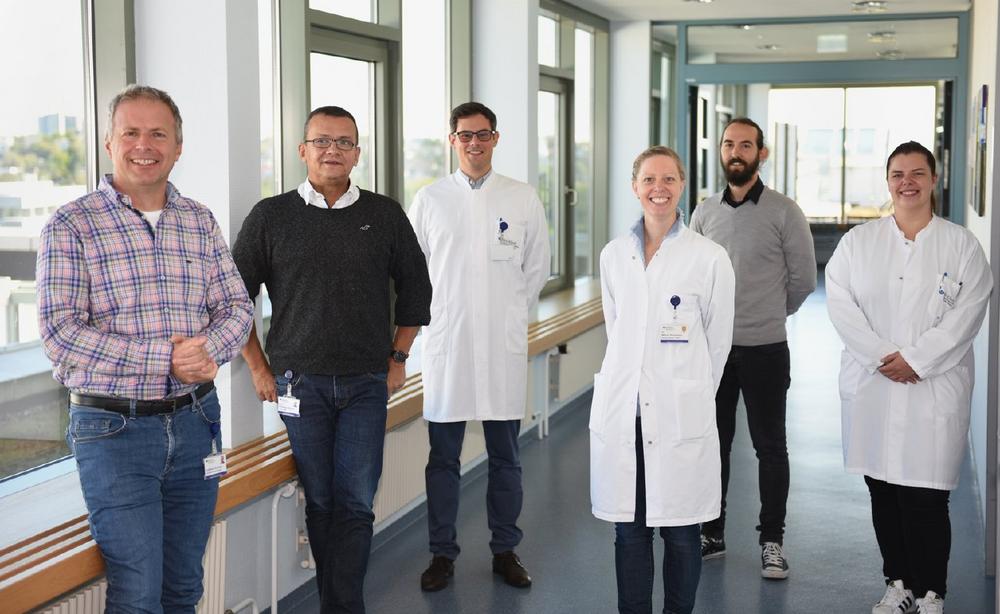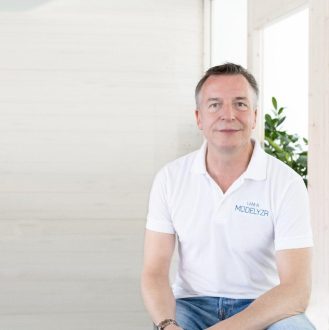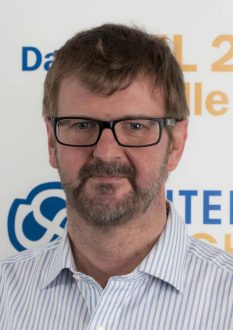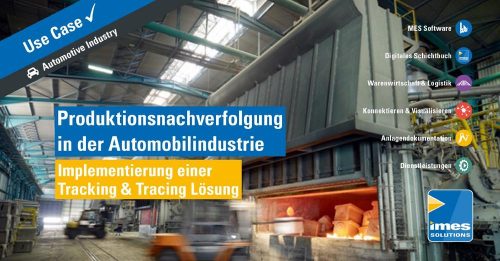
„The positive advances in technology deserve to be nurtured. AIQNET is a key project in our hospital.“
Prof. Nüssler, what sparked your interest in AIQNET?
As a scientist, I’m always looking for and scrutinising new discoveries. Around a year ago, BioRegio STERN Management GmbH asked me whether I’d take part in an initial project meeting in Tuttlingen. This exploratory discussion was extremely interesting and instrumental in my involvement in the project. AIQNET has the potential to shape the future of medicine.
Why do you feel there is a need for an “ecosystem for medical data”?
Huge volumes of data are collected for medical reasons in every hospital. This data is stored in various archive systems, frequently in an unstructured way. For example, patients come from their family doctor with a doctor’s letter on paper, test results come in PDF format, laboratory findings are added later on, etc. The idea is to structure all this data, gather it together in one database and then use AI to evaluate it.
AIQNET offers the opportunity for AI to facilitate real progress for the benefit of patients. Besides the high level of expertise among the project participants, the funding is also appealing. Although everyone wants IT and AI, there often either is no funding available, or applications for funding fail due to formalities. That is why this project provides an opportunity to make optimum use of these resources. We see ourselves as pioneers of cutting-edge healthcare.
Why is it a good idea to use artificial intelligence to structure and evaluate clinical data?
I’d like to give you a specific example. One area we’ve been researching at the hospital for some time now – and which is also being intensively studied as part of the project – is the relationship between various secondary conditions affecting patients and their impact on outcomes. AIQNET gives us the chance to combine AI with our existing research methods. We already have a dedicated database on this subject, and as a result of this we have identified that a proportion of patients have an increased risk of malnutrition. Although malnutrition is treated in Germany, this treatment is only given after the condition has presented itself. The preliminary stage – i.e. the heightened risk of malnutrition – is not treated. We therefore used the Nutrition Risk Score (NRS) to classify the nutritional status of patients due to be operated on at the hospital. In other words, we investigated whether a risk of malnutrition is present or not. Patients with an increased risk of malnutrition had a greater risk of developing a complication than those without such a risk. It is therefore conceivable that a protein-rich diet, or a substitute, could additionally be given to these patients prior to a knee or hip implant operation, for example. Patients would thus be treated even before surgery to ensure they arrive at the hospital in a better condition and recover faster afterwards. An overarching correlation has been identified and patients with worse chances could suddenly hope for a “normal” recovery again.
Naturally the same principle applies to other conditions, such as being overweight and having diabetes in combination with a liver disease. Surgeons then know they need to take particular care. These new findings could also improve aftercare.
That sounds primarily as if the pre-surgery medical history form would be even longer. What role is AI to play here?
Firstly, existing data is to be collated in one place – the analogue doctor’s letters, the results, the laboratory parameters and then naturally also the information about the future implant. The aim is to make this wealth of information manageable again.
If secondary conditions are systematically recorded, then we can answer questions such as “is this implant better suited to a specific group of patients than another implant?” It all comes down to comorbidity. We anticipate that AI – if trained appropriately – will itself conclude, based on the collated patient data, that a particular patient has a particular problem. That could be an increased risk of malnutrition, for instance. A suitable course of action can then be devised just as quickly. Naturally it must always be reviewed. However, having AI provide recommendations like these is particularly beneficial for other, less experienced colleagues or in smaller hospitals that do not have this volume of patients. In this case, AI can help us achieve improved, customised treatment – and a better outcome.
Why were knee implants chosen as the use case for the collaboration with the medtech manufacturer Aesculap AG?
Firstly, a large volume of data needs to be generated for the project, so we can see whether our digital ecosystem really works in this use case. Secondly, the correlation between risks with knee implants and secondary conditions can be easily tracked. The BG Hospital Tübingen is a large trauma hospital where a very high number of knee implants are successfully fitted each year. The various processes are very effectively recorded by our quality management system.
Despite the best surgical technology and the best implants, patients do not all have the same recovery chances. Patients with diabetes have a high risk of developing a diabetic osteopathy. They therefore have a greater risk of developing complications if they need a knee implant, for example. We see diabetes in almost 13 per cent of all cases. Overall, 20 to 25 per cent of our patients have an increased risk of malnutrition. In geriatric trauma surgery, the risk of malnutrition is even higher, at 30 to 40 per cent. With over 10,000 operations a year at our hospital, this is a large number of risk factors that patients bring with them from home.
How important do you think it is in everyday medical practice to use AI to improve, among other things, the way the performance and safety of medical products is measured?
It isn’t just patients’ secondary conditions that are being scrutinised, but the medical products, too. It is first necessary to decide which of the available implants is suitable for a given patient in a particular situation. At the end of the day, patients need to be given the implant that is best suited to them. Based on the data and using AI, surgeons can then better assess whether to choose prosthesis A, B or C for a patient in particular circumstances or with specific secondary conditions. What’s more, we could also show manufacturers, for example, that when using implant XY under a particular set of circumstances, the majority of patients have a negative outcome. Such knowledge is only gained from large data volumes. After all, if something doesn’t work, it may be entirely coincidental that we observe these progressions here in Tübingen that produce a completely different outcome when looking at Germany as a whole. However, if a negative correlation were identified, the manufacturer could carry out reworking in the interests of patient safety. If a particular implant is associated with a higher rate of infections when the patient has a specific immunological component, the manufacturer can consider whether the implant would benefit from an antibacterial coating, for instance. Other medical products may also perhaps be withdrawn from the market. AIQNET is thus creating a more objective assessment platform, e.g. for implants. We also expect AI to enable appropriately clear recommendations.
How do hospitals and manufacturers benefit from the close collaboration between the healthcare sector and industry in this project?
In this project, we have two use cases – high-risk patients and knee implants – where there is an overlap. The overriding objective for hospitals is the earliest possible identification of high-risk patients and the option of being able to query risks at the touch of a button. This then makes it possible to minimise conceivable complications from surgery, and treatment is improved objectively and subjectively. Manufacturers benefit because AIQNET makes it easier for them to meet the requirements of the MDR (Medical Device Regulation) for their products. They receive hospital data from thousands of procedures, which helps them validate their products more effectively. Incidentally, actually obtaining this data is nothing new in itself. To date, all findings are the result of exhaustive clinical studies. AIQNET aims to simplify the process of acquiring this knowledge. The close collaboration between the project partners is important, not least to establish interfaces between healthcare and industry. However, there is still much to discuss – once we have established the digital ecosystem, how do we handle it in the years ahead? At what point and in what ways can the additional outlay on data processing be paid for? One view is that the data is being collected anyway and is already paid for by health insurance providers, but this is unfortunately not correct. The IT company that oversees the evaluation process must also be paid. Digitalising and converting processes requires resources and takes a lot of work. Consequently, there will still be a great deal of discussion about how to handle the available data and the conclusions to be drawn from it.
Are ethical considerations and data protection laws crucially important in your view?
Yes, they are. Patients should naturally make their data available voluntarily. But how do you handle this data in line with data protection requirements? How is data stored? How is data shared? It isn’t simply a case of saying: “Give us the data and we’ll get on with it.” As hospitals, we do a huge amount of work to comply with statutory regulations, operate IT security systems and explain to patients that they can make their data available. We need to make it clear to them that they benefit from this the most. At the same time, our interface is designed to protect patients from unauthorised data usage. We take our role in the consortium very seriously. But naturally everyone working in the healthcare system benefits, including industry, health insurance providers, the Ministry of Health and so on.
Why does AIQNET need you and your expertise?
I have been promoting the issue of “identifying high-risk patients in hospitals”, among other things, since 2007, and I’ve been able to gather a lot of experience, both positive and negative. Now I have the opportunity to bring this experience to bear for AIQNET and in establishing a digital ecosystem. All the same, I don’t have any particularly great affinity with technology. I’m over 60 now and typed my PhD on a typewriter. But I have gradually adapted and realise that we don’t just need IT in our day-to-day lives. Cutting-edge technology has become the norm in my research department. The problem sometimes is that hospitals and associations shy away from it. However, in that case, you simply have to develop a thick skin and overcome resistance. The positive advances in technology deserve to be nurtured. I’m certainly assertive enough to get this project on the road. AIQNET is now one of the key projects in this major trauma hospital with over 10,000 clinical procedures. It has taken a little time, but I believe we have now won over (almost) everyone here.
AIQNET is a digital ecosystem that enables the use of medical data across sectors and in compliance with data protection regulations. The entire project is coordinated by BioRegio STERN Management GmbH, Stuttgart. Initiator and consortium leader is RAYLYTIC GmbH, based in Leipzig.
The consortium of 16 established medical technology and healthcare companies won the German government’s Al petition in 2019 under the project acronym "KIKS". The project is funded by the Federal Ministry for Economic Affairs and Energy. Since January 2020, the project partners have been developing the technical infrastructure and its applications. The focus is on structuring data using artificial intelligence and creating a legally secure framework. In the future, for example, the performance and safety of medical devices can be measured objectively and largely automatically. Administrative tasks of healthcare, e.g. documentation, can be handled by relevant applications. A special feature of the project is the close cooperation between industry, research and healthcare.
By providing access to technical and scientific data with great depth, the ecosystem offers future partners the opportunity to develop their own health applications at low cost and to benefit from the legally secure, validated framework of AIQNET.
AIQNET
Petersstr. 32-34
04109 Leipzig
Telefon: +49 711 870354 23
http://www.aiqnet.eu
BioRegio STERN Management GmbH
Telefon: +49 711 870354-23
E-Mail: reutter@bioregio-stern.de
![]()





